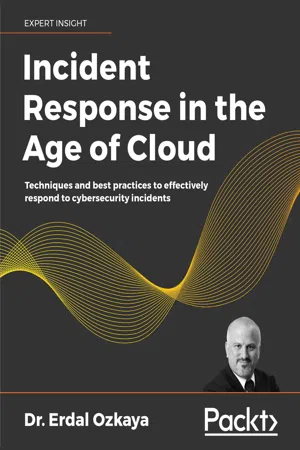
Incident Response in the Age of Cloud
Techniques and best practices to effectively respond to cybersecurity incidents
- 622 pages
- English
- ePUB (mobile friendly)
- Available on iOS & Android
Incident Response in the Age of Cloud
Techniques and best practices to effectively respond to cybersecurity incidents
About this book
Learn to identify security incidents and build a series of best practices to stop cyber attacks before they create serious consequences
Key Features
- Discover Incident Response (IR), from its evolution to implementation
- Understand cybersecurity essentials and IR best practices through real-world phishing incident scenarios
- Explore the current challenges in IR through the perspectives of leading experts
Book Description
Cybercriminals are always in search of new methods to infiltrate systems. Quickly responding to an incident will help organizations minimize losses, decrease vulnerabilities, and rebuild services and processes.
In the wake of the COVID-19 pandemic, with most organizations gravitating towards remote working and cloud computing, this book uses frameworks such as MITRE ATT&CK® and the SANS IR model to assess security risks.
The book begins by introducing you to the cybersecurity landscape and explaining why IR matters. You will understand the evolution of IR, current challenges, key metrics, and the composition of an IR team, along with an array of methods and tools used in an effective IR process. You will then learn how to apply these strategies, with discussions on incident alerting, handling, investigation, recovery, and reporting.
Further, you will cover governing IR on multiple platforms and sharing cyber threat intelligence and the procedures involved in IR in the cloud. Finally, the book concludes with an "Ask the Experts" chapter wherein industry experts have provided their perspective on diverse topics in the IR sphere.
By the end of this book, you should become proficient at building and applying IR strategies pre-emptively and confidently.
What you will learn
- Understand IR and its significance
- Organize an IR team
- Explore best practices for managing attack situations with your IR team
- Form, organize, and operate a product security team to deal with product vulnerabilities and assess their severity
- Organize all the entities involved in product security response
- Respond to security vulnerabilities using tools developed by Keepnet Labs and Binalyze
- Adapt all the above learnings for the cloud
Who this book is for
This book is aimed at first-time incident responders, cybersecurity enthusiasts who want to get into IR, and anyone who is responsible for maintaining business security. It will also interest CIOs, CISOs, and members of IR, SOC, and CSIRT teams. However, IR is not just about information technology or security teams, and anyone with a legal, HR, media, or other active business role would benefit from this book.
The book assumes you have some admin experience. No prior DFIR experience is required. Some infosec knowledge will be a plus but isn't mandatory.
Frequently asked questions
- Essential is ideal for learners and professionals who enjoy exploring a wide range of subjects. Access the Essential Library with 800,000+ trusted titles and best-sellers across business, personal growth, and the humanities. Includes unlimited reading time and Standard Read Aloud voice.
- Complete: Perfect for advanced learners and researchers needing full, unrestricted access. Unlock 1.4M+ books across hundreds of subjects, including academic and specialized titles. The Complete Plan also includes advanced features like Premium Read Aloud and Research Assistant.
Please note we cannot support devices running on iOS 13 and Android 7 or earlier. Learn more about using the app.
Information
15
Ask the Experts
- Approaches to IR
- Orin Thomas – Cloud security requires an updated mindset
- Tyler Wrightson – Know thy enemy
- George Balafoutis – The acronym that should be in every CISO's vocabulary
- Yilmaz Degirmenci – Cybersecurity visibility analysis: a soldier's analysis
- IR in the cloud
- Brian Svidergol – Incident response fundamentals
- Mark Simos – The cloud transformation journey
- Hala ElGhawi – Cloud incident management and response
- Ahmed Nabil – Incident response in the cloud
- Tools and techniques
- Emre Tinaztepe – The case: a modern approach to DFIR
- Raif Sarica and Sukru Durmaz – Remote incident response with DFIR
- Santos Martinez – Protecting corporate data on mobile devices
- Ozan Veranyurt – Artificial intelligence in incident response
- Attack methods
- Gokhan Yuceler – Analyzing a target-oriented attack
- Grzegorz Tworek – Windows object permissions as a back door
Approaches to IR
Orin Thomas – Cloud security requires an updated mindset
Tyler Wrightson – Know thy enemy
- Level of skill
- Previous tactics—entire kill chain; Tactics, Techniques, and Procedures (TTPs)
- Motives or agenda—intentions or plan to execute
Level of skill
- The age of the vulnerabilities exploited
- The age of the exploits utilized
- How common/esoteric is the vulnerability?
- The targeted nature of attacks
Table of contents
- Preface
- Getting Started with Incident Response
- Incident Response – Evolution and Current Challenges
- How to Organize an Incident Response Team
- Key Metrics for Incident Response
- Methods and Tools of Incident Response Processes
- Incident Handling
- Incident Investigation
- Incident Reporting
- Incident Response on Multiple Platforms
- Cyber Threat Intelligence Sharing
- Incident Response in the Cloud
- Building a Culture of Incident Readiness
- Incident Response Best Practices
- Incident Case Studies
- Ask the Experts
- Other Books You May Enjoy
- Index